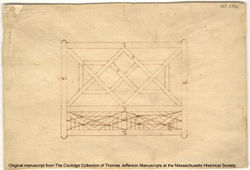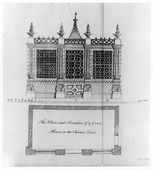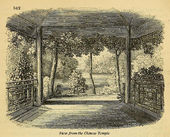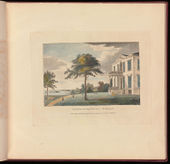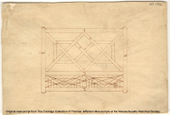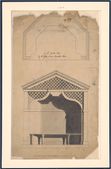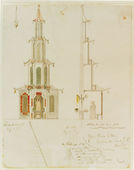Chinese manner
(Chinese Taste)
History
The term Chinese was used to describe both architecture and ornamental details found on garden façades or garden structures; it also described the layout of a garden. Features such as geometrically inspired trellises on a veranda, upward-turning curves on roofs, and small bulbous domes suggested East Asian influences rather than reproducing any authentic examples. In terms of garden layout, scenes of Chinese gardens drawn by missionaries and diplomatic staffs, as well as by Sir William Temple in his influential treatise, “Upon the Gardens of Epicurus” (1685), introduced the idea that variety, novelty, and surprise were characteristic of Chinese gardens, which meant that irregularity rather than symmetry prevailed.[1] These impressions of the characteristics of Chinese garden design persisted; in the 19th century, writers such as J. C. Loudon and A. J. Downing debated whether the Chinese taste in gardening was the closest historic style to, if not the same as, the modern in landscape gardening.
By the mid-18th century, the Chinese manner was used as the theme of public and private pleasure gardens, including the Pagoda and Labyrinth Garden [Fig. 1] and Gabriel Manigault’s China Retreat, both in Philadelphia. The names for these pleasure gardens, the first of which was dominated by a giant pagoda, were chosen to evoke the fantasy and exoticism associated with China in this period.
Lucrative commerce in the colonies helped to stimulate an interest in the Far East. As decorative objects, ceramics, and lacquered cabinets poured into the West in the 17th and 18th centuries, a taste for things Chinese grew. The increasing popularity of pattern books and design treatises during the same period helped spread Western ideas about China. Many of the Chinese-style details in American gardens derived from books such as William Halfpenny’s New Designs for Chinese Temples, triumphal arches, garden seats, palings, etc. (1750–52), Rural Architecture in the Chinese Taste (1755; written with his brother John), and Chinese and Gothic architecture properly ornamented (1752); William Chambers’s Designs of Chinese Buildings, Furniture, Dresses, Machines, and Utensils (1757) and A Dissertation on Oriental Gardening (1772); and Thomas Chippendale’s The Gentlemen and Cabinet-Maker’s Director. . . in the Gothic, Chinese and Modern Taste (1755). These were immensely popular in England and France and known in the colonies and early republic throughout the East Coast. Many drawings for designs in the Chinese manner can be traced to these publications.
For example, Jefferson’s sketch for a “Chinese railing” [Fig. 2]—which was used extensively at Monticello and at the University of Virginia—is similar to plates in Halfpenny [Fig. 3] or Chippendale. Bridges, verandas, gates, garden furniture, and light frame summerhouses could easily be given a Chinese flair with criss-cross lattice work. Chambers’ Great Pagoda at Kew, reproduced in his widely known Plans, Elevations, Sections, and Perspective Views of the Gardens and Buildings at Kew in Surry (1763) [Fig. 4], served as the model for many pagodas such as the one by Haviland (see Fig. 1).
Charles Willson Peale built a summerhouse for himself in the Chinese taste, which he described as being built of thin posts with arched brackets holding up the roof. Because he considered the Chinese to be philosophers, Peale dedicated this structure to meditation, inscribing it with a long verse that ended with these words: “Then let me ask myself, why am I here? am I blessed with more profound reason than other Animals, if so, Lett me be thankful; let me meditate of the past, on the present and on the future.”[2] This frequent association with meditative repose, poetry, and private delight made the Chinese manner appropriate for the garden, which was seen to be a place of peace and, as Peale noted, “rational Amusement.”
By the time Downing was writing about garden taste, a more archaeologically correct understanding of Chinese gardens, architecture, and decorative objects was available. Therefore his vehemence about the style and the notion of the English style originating in the Chinese can be understood as a more sophisticated understanding of what was actually Chinese. In Downing’s time, John Hare Otton made a series of drawings for proposed garden structures at Montgomery Place, one of which included an elaborate pagoda [Fig. 5]. In gardens the Chinese manner was continued in decorative details and ornament however, filtered through pattern and garden books.
—Therese O’Malley
Texts
Usage
- Murray, William, 18 June 1753, in a letter to his cousin, John Murray, describing Murraywhaite, home of John Murray, Charleston, SC (Colonial Williamsburg Foundation)
- “I hope you’ll raise it [the garden] in the English Taste & Leave near it proper accommodations for Hogs & Poultry to be hatched after the Chinese fashion.”
- Sansom, Hannah Callender, June 30, 1762, diary entry describing Belmont, estate of William Peters, near Philadelphia, PA (quoted in Callender 2010: 183)[3]
- “. . . in the garden are the Statues of Dianna, Fame & Mercury, with urns. we left the garden for a wood cut into Visto’s, in the midst a chinese temple, for a summer house, one avenue gives a fine prospect of the City, with a Spy glass you discern the houses distinct, Hospital, & another looks to the Oblisk.”
- Bucktrout, Benjamin, 1 September 1774, advertisement in the Virginia Gazette (quoted in Martin 1991: 206n24)[4]
- “[Will build] all sorts of Chinese and Gothick PALING for gardens and summer houses.”
- Cutler, Manasseh, July 28, 1787, describing New York, NY (1987: 1:307)[5]
- “Near by it [the prison] is what I at first took to be a beautiful summer-house, raised from the ground. It is in a square form, the sides ornamented with checker-worked banisters, and the roof in the Chinese taste; the whole very handsomely painted. I was surprised to see so elegant a summer-house so near this building, which I found, by the iron-grates to be a prison, but, on inspection, found it was a Gallows, accommodated or turning off six criminals at a time.”
- Bentley, William, June 12, 1791, describing Pleasant Hill, seat of Joseph Barrell, Charlestown, MA (1962: 1:264)[6]
- “[June] 12. Was politely received at dinner by Mr Barrell, & family, who shewed me his large & elegant arrangements for amusement, & philosophic experiments. . . His Garden is beyond any example I have seen. A young grove is growing in the back ground, in the middle of which is a pond, decorated with four ships at anchor, & a marble figure in the centre. The Chinese manner is mixed with the European in the Summer house which fronts the House, below the Flower Garden.”
- Caldwell, John Edwards, 1808, describing Monticello, plantation of Thomas Jefferson, Charlottesville, VA (1951: 38–39)[7]
- “The roofs of the passages, and range of buildings, form an agreeable walk, being flat and floored, and are to have a Chinese railing round them; they rise but a little height above the lawn, that they may not obstruct the view.”
- Anonymous, April 28, 1826, “On Landscapes and Picturesque Gardens” (New England Farmer 4: 316)[8]
- “A few fabrics, rustic bridges, hermitages, a Temple, or a Chinese Kiosk or Pagoda, not expensive in their execution, would advantageously complete the embellishment of a country seat. . .
- “Mr. [André] P[armentier]. by the advice of several of his friends, will furnish plans of landscape and picturesque gardens; he will communicate to gentlemen who wish to see him, a collection of his drawings of Cottages, Rustic Bridges, Dutch, Chinese, Turkish, French Pavilions, Temples, Hermitages, Rotundas, &c. For further particulars, inquiries personally, or by letter, addressed to him, post paid, will be attended to.”
- Peale, Charles Willson, October 30, 1814, describing Belfield, estate of Charles Willson Peale, Germantown, PA (Miller et al., eds., 2000: 5:380–81)[9]
- “The proprietor made summer houses (so called) roofs to ward off the Sunbeams with seats of rest. one made of the chinease [sic] taste, dedicated to medieation [sic], with the following sentiments round within it:
- “Mediate on the Creation of Worlds, which perform their evolutions in proscribed periods!”
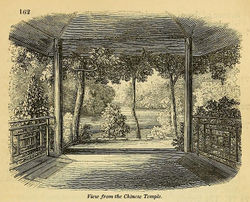
- Loudon, J. C. (John Claudius), December 1839, describing Cheshunt Cottage, property of William Harrison, near London, England (Gardener’s Magazine 15: 653)[10]
- “85, Double ascent of the steps to a mound formed of the earth removed in excavating for the pond. From the platform to which these steps lead, there is a circuitous path to the Chinese temple, and the steps are ornamented with Chinese vases, thus affording a note of preparation for the Chinese temple. The outer sides of the steps are formed of rockwork, and between the two stairs is a pedestal with Chinese ornaments.
- “86, The Chinese temple, on the highest part of the mount formed of the soil taken from the excavation now constituting the pond. The view from the interior of this temple is shown in. . . [Fig. 6]
Citations
- Gregory, G. (George), 1816, A New and Complete Dictionary of Arts and Sciences (1816: 2:n.)[11]
- “GARDENING. . .
- “Figured parterres have got out of fashion, as a taste for open and extensive gardening has prevailed; but when the beds are not too fanciful, but regular in their shapes, and chiefly at right angles, after the Chinese manner, an assemblage of all sorts of flowers, in a fancy spot of about 60 feet square, is a delightful home scource [sic] of pleasure, worthy of pursuit. There should be neat edgings of box to these beds, or rather of neat inch-boards, painted lead colour, to keep up the mould.”

- Loudon, J. C. (John Claudius), 1826, An Encyclopaedia of Gardening (1826: 103, 792–93, 996)[12]
- “478. A plan of a Chinese garden and dwelling. . . If this plan. . . is really correct, it seems to countenance the idea of the modern style being taken from that of the Chinese. . . [Fig. 7]
- “6093. . . There are other characters of gardens, such as Chinese, which are not widely different from the modern. . .
- “7161. . . Mason, the poet, invokes ‘simplicity,’ probably intending that this beauty should distinguish the English from the Chinese style: simplicity is also the ruling principle of Lord Kames.”

- Loudon, J. C. (John Claudius), 1834, An Encyclopaedia of Gardening (1834: 334)[13]
- “The [octagon] pagoda. . . was intended to be eighty-eight feet high. It is placed on an island, in the centre of a small pond, and was to have been approached by a Chinese bridge richly ornamented. The diameter of the base of the pagoda is forty feet, and there were to have been six stories, the lower one of stone, and the others of cast iron. From the angles were to have been suspended forty highly enriched Chinese lamps, and these were to be lighted by a gasometer fixed in the lower story. Besides the lamps, there were to have been grotesque figures of monsters projecting over the angles of the canopies, which were to spout water from their eyes, nostrils, fins, tails, &c.; a column of water was also to have been projected perpendicularly from the terminating ornament on the summit of the structure, which, from the loftiness of the source of supply, would have risen to the height of seventy or eighty feet.” [Fig. 8]
- Downing, Andrew Jackson, 1849, A Treatise on the Theory and Practice of Landscape Gardening (1849; repr. 1991: 36, 237)[14]
- “It is not a little remarkable that the Chinese taste in gardening, which was at first made known to the English public about this time, is by far the nearest previous approach to the modern style. Some critics, indeed, have asserted that the English are indebted to it for their ideas of the modern style. However this may be, and we confess it has very little weight with us, the harmonious system which the taste of the English has evolved in the modern style, is at the present day too far beyond the Chinese manner to admit of any comparison. The first is imbued with beauty of the most graceful and agreeable character, based upon nature, and refined by art; while the latter abounds in puerilities and whimsical conceits—rocky hills, five feet high—miniature bridges—dwarf oaks, a hundred years old and twenty inches in altitude— which, whatever may be our admiration for the curious ingenuity and skill tasked in their production, leave on our mind no very favorable impression of the taste which designed them. . .
- “To these offices of pensive melancholy, it [the Weeping willow] appears to be dedicated in almost all countries. The Chinese and other Asiatic nations, and the Turks, as well as the enlightened Europeans, universally plant it in their cemeteries and last places of repose.”
Images
Inscribed
William and John Halfpenny, “A Single Truss’d Bridge in the Chinese Taste,” in Rural architecture in the Chinese taste (1755), pl. 27.
William and John Halfpenny, “The Plan and Elivation of a Green House in the Chinese Taste,” in Rural Architecture in the Chinese Taste (1755), pl. 42.
William and John Halfpenny, “The Plan and Elivation of a Temple, or Summer House, on a Tarras, In the Chinese Taste,” in Rural Architecture in the Chinese Taste (1755), pl. 44.
William and John Halfpenny, “An Obelisk in the Chinese Taste,” in Rural Architecture in the Chinese Taste (1755), pl. 24.
William and John Halfpenny, “A Single Truss’d Bridge in the Chinese Taste,” in Rural architecture in the Chinese taste (1755), pl. 25.
J. C. Loudon, “View from the Chinese Temple,” Cheshunt Cottage, in The Gardener’s Magazine 15, no. 117 (December 1839): 651, fig. 162.
Associated
William Marlow, “A View of the Wilderness, with the Alhambra, the Pagoda and the Mosque,” in William Chambers, Plans, Elevations, Sections, and Perspective of the Gardens and Buildings of Kew in Surry, (1763), pl. 43.
William Russell Birch, “China Retreat Pennsyl.a the Seat of M.r Manigault,” 1808, in William Russell Birch and Emily Cooperman, The Country Seats of the United States (2009), 79, pl. 19.
Attributed
Thomas Jefferson, Drawing for a gate in Chinese lattice at Monticello, c. 1771.
Cornelia Jefferson Randolph, attr., “A Garden Seat by Mr. Jones, From Chamber’s Kew,” c. 1820.
John Hare Otton, Design for a Garden Pagoda at Montgomery Place, 1839—47.
Notes
- ↑ Sir William Temple, “Upon the Gardens of Epicurus; or, Of Gardening, in the Year 1685,” in Five Miscellaneous Essays by Sir William Temple, ed. Samuel Holt Monk (Ann Arbor: University of Michigan Press, 1963), 1–36, view on Zotero.
- ↑ Horace Wells Sellers’s transcript of Charles Willson Peale, Autobiography, P-S, F: IIC, 390.
- ↑ Hannah Callender Sansom, The Diary of Hannah Callender Sansom: Sense and Sensibility in the Age of the American Revolution, ed. Susan E. Klepp and Karin Wulf (Ithaca: Cornell University Press, 2010), view on Zotero.
- ↑ Peter Martin, The Pleasure Gardens of Virginia: From Jamestown to Jefferson (Princeton, NJ: Princeton University Press, 1991), view on Zotero.
- ↑ William Parker Cutler, Life, Journals, and Correspondence of Rev. Manasseh Cutler, LL.D. (Athens: Ohio University Press, 1987), view on Zotero.
- ↑ William Bentley, The Diary of William Bentley, D.D., Pastor of the East Church, Salem, Massachusetts (Gloucester, MA: Peter Smith, 1962), view on Zotero.
- ↑ John Edwards Caldwell, A Tour through Part of Virginia, in the Summer of 1808; Also, Some Account of the Islands of the Azores, ed. William M. E. Rachal (Richmond, VA: Dietz, 1951), view on Zotero.
- ↑ Anonymous, “On Landscape and Picturesque Gardens,” New England Farmer 4, no. 40 (April 28, 1826): 316, view on Zotero.
- ↑ Lillian B. Miller et al., eds., The Selected Papers of Charles Willson Peale and His Family, vol. 5, The Autobiography of Charles Willson Peale (New Haven, CT: Yale University Press, 2000), view on Zotero.
- ↑ J. C. Loudon, “Descriptive Notices of Select Suburban Residences, with Remarks on Each; Intended to Illustrate the Principles and Practices of Landscape-Gardening,” Gardener’s Magazine and Register of Rural & Domestic Improvement 15, no. 117 (December 1839): 633–74, view on Zotero.
- ↑ George Gregory, A New and Complete Dictionary of Arts and Sciences, 1st American ed., 3 vols. (Philadelphia: Isaac Peirce, 1816), view on Zotero.
- ↑ J. C. (John Claudius) Loudon, An Encyclopaedia of Gardening; Comprising the Theory and Practice of Horticulture, Floriculture, Arboriculture, and Landscape-Gardening, 4th edn (London: Longman et al, 1826), view on Zotero.
- ↑ John Claudius Loudon, An Encyclopædia of Gardening: Comprising the Theory and Practice of Horticulture, Floriculture, Arboriculture, and Landscape Gardening; Including All the Latest Improvements; a General History of Gardening in All Countries; and a Statistical View of Its Present State; with Suggestions for Its Future Progress in the British Isles, new ed. (London: Longman, Rees, Orme, Brown, Green, and Longman, 1835), view on Zotero.
- ↑ A. J. [Andrew Jackson] Downing, A Treatise on the Theory and Practice of Landscape Gardening, Adapted to North America, 4th ed. (1849; repr. Washington, DC: Dumbarton Oaks Research Library and Collection, 1991), view on Zotero.

